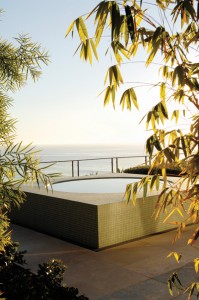Want to merge your landscape with its surroundings? Get creative.
There is perhaps nothing more breathtaking and peaceful than a view of the ocean. So what can someone possibly do to magnify the magic of the water in an outdoor living space? For landscape architect Pamela Palmer of Artecho Architecture and Landscape Architecture, the solution is straightforward: simply add more water and “lead up to it.”
At least that was one of the critically acclaimed creative touches Palmer incorporated on a prime blufftop property on the Palos Verdes Peninsula in Southern California. PalmerÂ’s work at the Lunada Bay Residence earned the Venice, California-based architect the Residential Design Honor Award in 2007 from the American Society of Landscape Architects.
Of course, working on such craggy coastal properties can have its challenges, what with the pounding surf and driving wind that often brings salty air, heavy mists, and other inclement conditions. Naturally, Palmer says it’s important to be mindful of planting rugged materials and ensuring that natural surface stones and concretes have an appropriate coefficient of friction to minimize slippery spots. One special tip is to buy certain sand-finished concrete that has “a bit of texture so it’s not slippery, yet it’s not quite like an aggregate, so it creates a beautiful surface.”
There are also some interesting gravel materials, Palmer adds, that can make nice pathways and even add a great design element, like some blue stone paving in Malibu that not only matches the color of the ocean but mimics the waves with its unique patterns. As for actual water touches, watery cast glass lit from below, a shallow pond that reflects the sky, and water spilling over stone walls are just a few of the lovely touches at Lunada Bay.
“When you’re developing property on the coast, whether it’s oceanfront or bayfront, really what you’re doing is creating a foreground, because your view is really the larger landscape,” Palmer says. “You’re kind of setting up a stage for life on the foreground. Then you have this whole view that becomes really the main focus. You’re in the space you’re creating, and the view is your focal point.” —By Scott Kaufman




